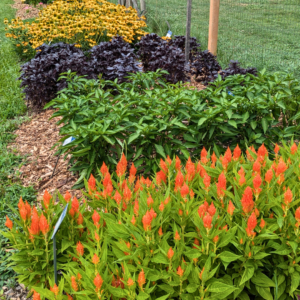
All-America Selections Garden
All-America Selections (AAS) is an independent agency that has been testing seed-grown plants for superiority since 1932. This garden area features a collection of annuals, vegetables, and even a few perennials—all grown from seed—that have been rigorously tested and released by the AAS as the best in their categories. Whether its merits are early bloom or harvest, disease or pest tolerance, novel colors or forms, yield, or overall great performance, the AAS Winner label is like a stamp of approval.
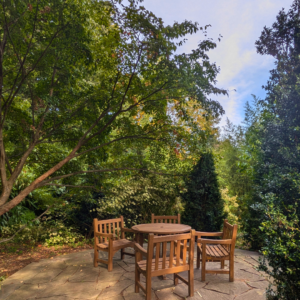
Art Rudolph Sun and Shade Garden
Arthur Rudolph was a beloved sales representative from Monrovia Nursery. This garden, named for him, highlights plants that will provide color and interest in a part-sun and part-shade setting, as is typical of many home gardens. Gardeners can gain inspiration from the many lovely monocots and native perennials.
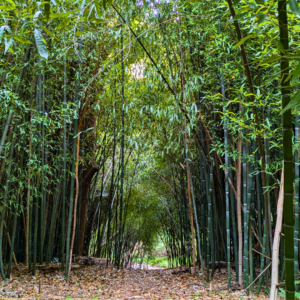
Bamboo Grove
Initially planted as a wind screen for honeybee colonies in the 1940's, this aggressive form of hardy, evergreen bamboo (Phyllostachys nuda) now forms a large grove nearly 2 acres in size. Each season, new culms grow to over 30 feet in just weeks! Throughout the seasons, this grove never fails to transfix visitors and has become a popular spot for photography.
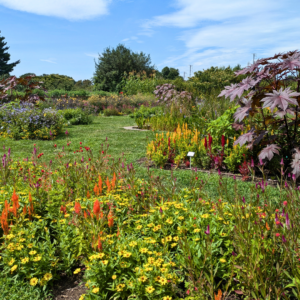
Donald B. Lacey Display Garden
Named for the extension specialist who helped convert a massive bed of irises into a demonstration garden of annuals for the home landscape in 1964, this garden has grown into an incredible display of unusual and colorful annuals, tropicals, herbs, and vegetables. Surrounded by perennial borders and arranged in a formal pattern around a central pond, the design changes yearly, and is always a big attraction for visitors and photographers.
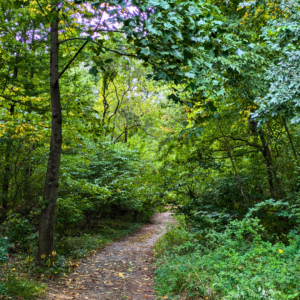
Helyar Woods
Around 60 acres, Helyar Woods is named for a professor and longtime proponent of woodlands and hiking, Frank G. Helyar, who was also director of various programs at the College of Agriculture from 1917 to 1953. Helyar Woods is composed mostly of old-growth beech, birch, maple and oak trees.
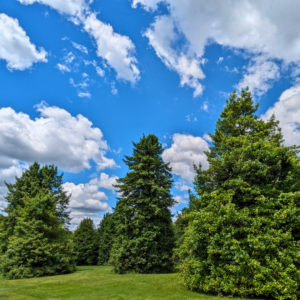
Holly Collection
One of the largest collections of American Hollies in the United States, some of the mature specimens date back to the 1930s. Originally established for uation and called the "Holly Orchard," the large trees now stand as a testament to the decades-long breeding program that arose from it. In addition to American Hollies (Ilex opaca), the collection includes Winterberry Hollies as well as numerous hybrids.
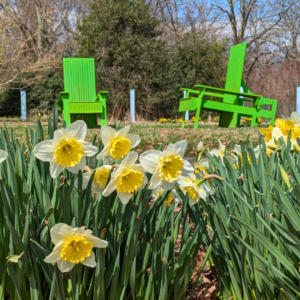
Edwin J. and Ida M. Otken Memorial Garden
Perhaps most recognized for the iconic oversized green Adirondack chairs in the center, the Otken Memorial Garden features a mixed border of shrubs, perennials, and ornamental grasses, along with walking paths.
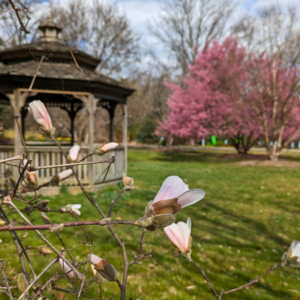
Ornamental Tree Collection
Ornamental or "small" trees are ideal for the average residential landscape, and a number of the unusual varieties here have reached a size and maturity not often seen in New Jersey gardens. Among our collection you will find the state's largest Paperbark Maple (Acer griseum), a NJ State Champion Two-Winged Silverbell (Halesia diptera), a large Persian Ironwood (Parrotia persica), India Quassia (Picrasma ailanthoides), and Chinese Dogwood (Cornus kousa ssp. chinensis).
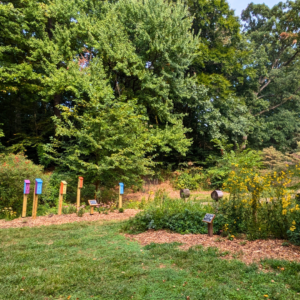
Pollinator Garden
The Pollinator Garden is mindful of the specialized relationship between native plants, water sources, responsible horticultural practices, and the many diverse pollinators that these plants support. Many of the plant species require the help of pollinators in order to set seed, and in exchange, the plants provide food, shelter, and migratory sites.
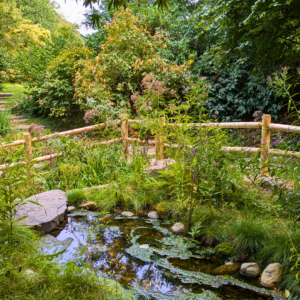
Rain Garden
The main objective of a rain garden is to reduce stormwater runoff from impermeable surfaces, to combat erosion and sedimentation of local streams and rivers, and to help remove pollutants in the water. This garden is designed with these positive environmental aspects in mind.
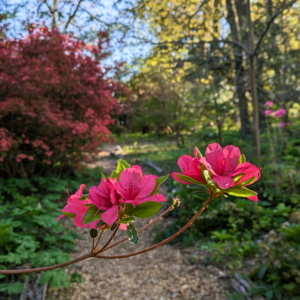
Rhododendron Garden
Begun in the 1930s, this garden integrates small trees, a variety of shrubs (focusing on Rhododendrons), hellebores, and a number of mature and unique trees including a Dove Tree (Davidia involucrata), Dawn Redwood (Metasequoia glyptostroboides) and Kousa Dogwoods (Cornus kousa).
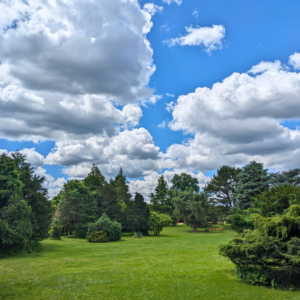
Roy H. DeBoer Evergreen Garden
Roy DeBoer, former Chairman of the Landscape Architecture Department, designed this area in 1958. The plants are grouped by genus, featuring Weeping White Pine and a host of Cedars, Pines, Spruces and Firs.

Shade Tree Collection
A large number of mature shade trees, including Linden (Tilia), Buckeye (Aesculus), Elm (Ulmus), and Beech (Fagus), can be found in this collection. Look for the less common specimens such as Bee Bee Tree (Tetradium daniellii), Dayimo Oak (Quercus dentata) and Chinese Toon Tree (Cedrella chinensis).
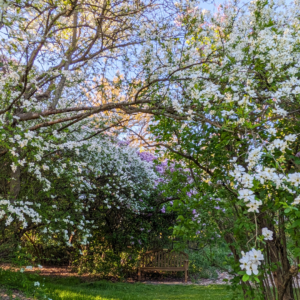
Shrub Garden
Regarded as our "original collection," the oldest section contains many hybrid and species lilacs planted in 1927. Significantly expanded from the late 1930s through the early 50s by Ben Blackburn, a Rutgers professor, some of the highlights include Vernal Witchhazel (Hamamelis vernalis), Winterhazel (Corylopsis spicata), Dwarf Bush Honeysuckle (Diervilla lonicera), Ninebark (Physocarpus opulifolius), and Alabama Snow Wreath (Neviusia alabamensis).